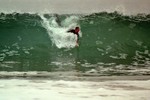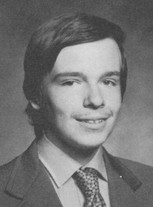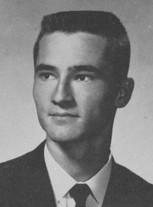South Pasadena High School
Alumni Association - 1907-2025
*Tiger Talk Forums
| Forum: The 1950's: South Pas Back Then | |||||
|
|||||
|
James Tomlin
Class Of '61
 Posts: 37 View Profile |
Kiner & West Posted Wednesday, January 27, 2010 06:51 PM
Kiner & West Growing up in the far northeastern corner of South Pasadena, I was familiar with our neighbors to the northeast in San Marino. The city border was the cement-contained creek that ran behind my friend Marty’s house, and we thought that the people across it looked down on us. The closest barber was in a little town center just over the line on Mission Street. I frequented that barber until I was about twenty one, but no time was more enjoyable than in my senior year at South Pasadena High when we beat San Marino in football, basketball and baseball. To the North of our house at 601 Milan was Pasadena, bordered by a freeway concealed by Las Flores hill. My parents often went to Pasadena to shop, but they didn’t stay long. Dave Moore and I used to ride our bikes up to the Pasadena YMCA to swim and play basketball and we once rode all the way to Altadena because we believed that Jackie Robinson lived there and we wanted to meet him. This was an adventure that was completely devoid of prior planning and predictably ended badly. To the west of South Pasadena, separated from us by the vast waters of the mighty Arroyo Seco was the city of Highland Park. For some reason, even when I became older and able to drive, we never went to Highland Park, and never felt we had missed anything. There were rumors of chollos in Zoot suits. Ah, but to the south lay Alhambra. Dave, who lived at the extreme southwestern part of South Pasadena, had already discovered Alhambra’s compelling and exotic Main Street, with its’ seedy bars and other attractions which were lacking in our fair city. We started hanging out together in the seventh grade. Alhambra was separated from South Pasadena only by the slender ribbon of blacktop called Alhambra Road. On one side of Alhambra Road the kids went to the South Pasadena schools, on the other, to Alhambra Unified. Therefore it was no surprise that many southern South Pasadena kids had friends across the border. From what I could determine from Dave Moore, and another friend, Dave Dickson, who at the time lived a block from Alhambra Road, no one on our side of the street would have wanted to trade places; not, in the vernacular of the times, “in a million years.” It goes without saying that no one would ever even consider that question in reference to Highland Park. We knew we lived in a special place, and were thankful for it. Nevertheless, Alhambra had its attractions, for one, Pedrini’s Record Store. Guido Pedrini was what might be called a purveyor of second-hand goods, and it being a point of honor with Dave not to frequent Dolly’s Records, or pay full price for one of the new 45 rpm records, Pedrini’s was a frequent destination. “Pete” also had a wealth of old magazines, which he would allow us to read as long as we purchased something at the end of the day. Piles of magazines formed a maze piled throughout the store, long-ago copies of Time, Look, Life, Saturday Evening Post, National Geographic and Sport waiting to be read and treasured once again. Although Dave professed indifference to formal schooling, and although his father was a school principal and his mother a librarian, Dave was, and is, a voracious reader. Many a Saturday included a morning of playing sports followed by lunch at Dave’s [tuna sandwiches with olives] topped off by a visit to Pedrini’s reading room [dusty, but comfortably ensconced among the ill organized stacks of books, magazines and records]. The day often ended with a visit to the Rialto Theater, which in those days cost 25 cents for children under 12. I was able to pull this off until I was nearly 15. As great as Pedrini’s was, it was not the most attractive store in Alhambra for me. Little League baseball started in 1954 in South Pasadena. Our parents, most of whom were born nearly one hundred year ago now, were the children of a horrible depression and the most destructive war the world had ever seen. These dads wanted to give their kids a childhood that they had never had. They enabled their children to play real baseball, with real uniforms on a real, albeit diminutive field. Perhaps only as adults could we appreciate their motivation and their journey. My Little League coach recommended that I purchase my baseball equipment at the Kiner & West Sporting Goods Store in Alhambra, there being no such store in South Pasadena. From the first time I walked into the store, I was home. Pictures and other baseball memorabilia lined the store, owned by Ralph Kiner and Max West, two former Major League baseball All Stars. I knew this because I was already collecting Topp’s Baseball cards. I learned long division figuring batting averages and ERAs. [How I wish my mom hadn’t given them all away when I left for college.] Readers should know that before 1958 there were no major league baseball teams west of the Mississippi. The Saint Louis Cardinals of the National League were the western most outpost of major league baseball in the 1950s. The New York Giants and the Cleveland Indians conducted spring training in California, and I remember my uncle taking me to an exhibition game in 1955 after those teams had played for the world championship in 1954, one of the first televised World Series. The blur of a major league fastball had to be seen to be believed. I was able to see all of the games of that World Series [the Giants, led by Willie Mays, won in four straight] because I was sick that week. Really, but recovery was swift. In each of his first seven years in Major League Baseball, Ralph Kiner led the National League in homeruns. His 10 year career statistics speak for themselves: twice he hit over 50 homeruns, drove in 100 or more runs six times, ranked first in slugging percentage three times, and averaged over 100 walks. In 1949 his 127 RBI was tops in the league. Kiner's career, shortened by a back injury, was complete in 1975 with his induction into the National Baseball Hall of Fame. Max West was an outfielder and first baseman from 1938 to 1948. An All Star in 1940, he played for seven seasons for several major league teams, although his career was interrupted by a tour during World War II as a turret gunner on a B-29. By the time my mom took me to the store for a complete baseball outfit [shoes, bat, baseball glove and a dozen balls], I knew who Kiner and West were, but again, you have to remember that professional athletes were not the rock stars of today. Can you imagine being waited on by Derek Jeter? Even the stars had off season jobs, and although Ralph wasn’t in the store that day, he had grown up in Alhambra, and he did work there during the off season. Max however, pretty much ran the store. I left that day with a mitt, some balls, shoes and a bat which cost about the same as the piano lessons I was ditching. I was one of the few kids on my team to actually own my own bat. Thanks mom, for giving up that new dress you wanted. The store was pretty busy the Saturday I went with my mom [she worked a 45 hour week], and I was disappointed that Max didn’t wait on us, but I memorized the circuitous route from our house to Alhambra’s Main Street, and rode my bike down after school the following week. I know, it was a simpler time, we rode our bikes everywhere. Did our parents worry about us? Max was alone in the store, high on a ladder arranging the baseball shoes. Almost immediately after the door opened and rang a bell I had an attack of the shys, and I could hardly talk. Despite his imposing physical presence and gruff demeanor, Max smiled and came down from the ladder. He had probably seen a lot of wide eyed little guys similarly afflicted and immediately said, “What’s your name?” “Jimmie,” I said, glad to get a question I could answer. I was talking to a major leaguer, a man who had faced the best pitchers of his day, Feller, Hubbell, Dean and who had talked hitting with the DiMaggio, Williams and Kiner. “You were in on Saturday. You on a team yet?” “Yes sir.” “And you came to talk some baseball.” I could only nod, and then I had a amazing half hour all to myself with Max. He spoke about his baseball career, and finally got around to his signature moment, a three run home run off Hall of Fame pitcher Red Ruffing of the New York Yankees that won the 1940 All Star game for the National League over an American League team that included Hall of Famers Joe DiMaggio, Hank Greenberg, Luke Appling, Ted Williams and Jimmy Foxx. After that magic half hour, I became a bit of a regular. My parents had split in 1946 and so my father wasn’t around to help coach my team, keep score or cheer my modest successes. Max would sometimes give me chores to do like dusting and sweeping which I performed while learning how to choose a bat, take care of your fielder’s glove and properly wear a uniform. I worked to a soundtrack of encyclopedic baseball knowledge, much of which of course didn’t apply to my ten year old level of baseball. Little Leaguers didn’t throw curves, or try to nibble the corners of the plate. I was a pitcher myself, lucky to find any part of home plate with my one pitch [hard as I could throw], but the knowledge of the game serves me well even today as I root for the Angels and second guess Mike Scioscia on Saturday afternoons. I wish I could have been the player Max coached me to be, but he did sell me my first set of track spikes, probably hiding his disappointment, but resigned since he had actually seen me play a couple of times. My eyes just weren’t good enough to hit a baseball, but I could run and this became my sport of choice through college. Today, Kiner & West is not even a memory on Alhambra’s Main Street. The store closed its doors in the mid 1970s and I lost track of Max. I was surprised to discover that he lived to the age of 87, and only passed away recently in 2003. I wish I had told him what it meant for a little kid of ten to talk to a major leaguer, although I think he knew. Near as I can tell, an Asian restaurant now rests upon that once revered ground. I stopped on Main Street recently but I couldn't even feel the presence of the old building, but I did hear the echoes of the rich tales of baseball lore that can still bring a smile and a tear. And still, in my mind’s eye I can see it all, the storefront, the bat rack and the smell of Rawlings leather coated in Glovolium. And most of all, the memory of Max climbing down off the ladder with a smile on his face. |
||||
|
|||||
|
Derek Gene Bird
Class Of '77
 Joined: 02/23/10 Posts: 17 View Profile |
RE: No love lost for Highland Park! Posted Saturday, March 27, 2010 03:53 PM I moved to South Pasadena from Highland Park in early 1969. Sheeew! What a narrow escape. It was late in the fourth grade. The gang influence and influx of less than desirable neighbors caused us to seek a better neighborhood and better schools. Just across the Arroyo was such a place. In my mind, I knew the worst part of SP was better than the best part of Highland Park. I felt safe once I was over the bridge, and deeply matriculated into South Pasadena Schools. We would move one more time before my graduation from SPHS. It turned out to be the last house on Monterey Road before crossing over the boundary back into Highland Park! It almost causes a retroactive nervous breakdown to think back on it. Even South Pasadena has it's faults........ but the worst of these turned out to be a branch of the San Andreas. I can live with that.
With my heart and mind, |
||||
|
|||||
|
Daniel Sherman Wilshire
Class Of '59
 Posts: 1 View Profile |
RE: Kiner & West Posted Wednesday, April 28, 2010 07:59 PM Great article. Strange, I grew up living at 633 Milan Ave. (half a block) from you, but graduated in '59. So close but we never played together. Maybe you remember the older kids on your block? Dan (Dewey) Wilshire. Mike McMillan, Doug Carlson, Bob Linville. My older brothers graduated in '53 (the year our football team went to CIF championship in the Coliseum (sp?) and '49. They both got their Phds from USC. I went on to get my Master in music and taught for 30 years in Glendora. Thanks for the memories! Dan (Dewey) Wilshire '59 SPHS |
||||
|
|||||